paint the image in a panel
protected void paintComponent(Grapchics g) {
super.paintComponent(g);
g.drawImage(image, 0, 0, this);
}
Then based on the the number of cells you want, say 10x10, just draw 100 cells (drawRect()) over the image. Something like
protected void paintComponent(Grapchics g) {
super.paintComponent(g);
g.drawImage(image, 0, 0, this);
int cellHeight = (int)(getHeight() / 10);
int cellWidth = (int)(getWidth() / 10);
for (int y = 0; y < getWidth(); y += cellHeight) {
for (int x = 0; x < getHeight(); x += cellWidth){
g.drawRect(x, y, cellWidth, cellHeight);
}
}
}
I haven't test it, but the basic concept is there. You may also want to use variables (a constant probably) for the 10.
UPDATE 1

You can see the precision's a little off because I used int, but you can use doubles and draw by using Grapchics2D Rectangle2D.Double. I'm too lazy to change it
import java.awt.Dimension;
import java.awt.Graphics;
import java.awt.GridBagLayout;
import java.awt.image.BufferedImage;
import java.io.IOException;
import java.util.logging.Level;
import java.util.logging.Logger;
import javax.imageio.ImageIO;
import javax.swing.JFrame;
import javax.swing.JPanel;
import javax.swing.SwingUtilities;
public class ImageGrid extends JPanel {
private static final int CELLS = 10;
BufferedImage img;
public ImageGrid() {
try {
img = ImageIO.read(getClass().getResource("/resources/stackoverflow5.png"));
} catch (IOException ex) {
Logger.getLogger(ImageGrid.class.getName()).log(Level.SEVERE, null, ex);
}
}
@Override
protected void paintComponent(Graphics g) {
super.paintComponent(g);
if (img != null) {
g.drawImage(img, 0, 0, this);
int cellHeight = (int) (getHeight() / CELLS);
int cellWidth = (int) (getWidth() / CELLS);
for (int y = 0; y < getHeight(); y += cellHeight) {
for (int x = 0; x < getWidth(); x += cellWidth) {
g.drawRect(x, y, cellWidth, cellHeight);
}
}
}
}
@Override
public Dimension getPreferredSize() {
return img == null ? new Dimension(300, 300)
: new Dimension(img.getWidth(), img.getHeight());
}
public static void main(String[] args) {
SwingUtilities.invokeLater(new Runnable() {
public void run() {
JFrame frame = new JFrame();
JPanel wrapperPanel = new JPanel(new GridBagLayout());
wrapperPanel.add(new ImageGrid());
frame.add(wrapperPanel);
frame.setDefaultCloseOperation(JFrame.EXIT_ON_CLOSE);
frame.pack();
frame.setLocationRelativeTo(null);
frame.setVisible(true);
}
});
}
}
UPDATE 2
With
JLabel
import java.awt.Graphics;
import java.awt.GridBagLayout;
import java.awt.image.BufferedImage;
import java.io.IOException;
import java.util.logging.Level;
import java.util.logging.Logger;
import javax.imageio.ImageIO;
import javax.swing.ImageIcon;
import javax.swing.JFrame;
import javax.swing.JLabel;
import javax.swing.JPanel;
import javax.swing.SwingUtilities;
public class ImageGrid extends JLabel {
private static final int CELLS = 10;
BufferedImage img;
public ImageGrid() {
try {
img = ImageIO.read(getClass().getResource("/resources/stackoverflow5.png"));
setIcon(new ImageIcon(img));
} catch (IOException ex) {
Logger.getLogger(ImageGrid.class.getName()).log(Level.SEVERE, null, ex);
}
}
@Override
protected void paintComponent(Graphics g) {
super.paintComponent(g);
if (img != null) {
int cellHeight = (int) (getHeight() / CELLS);
int cellWidth = (int) (getWidth() / CELLS);
for (int y = 0; y < getHeight(); y += cellHeight) {
for (int x = 0; x < getWidth(); x += cellWidth) {
g.drawRect(x, y, cellWidth, cellHeight);
}
}
}
}
public static void main(String[] args) {
SwingUtilities.invokeLater(new Runnable() {
public void run() {
JFrame frame = new JFrame();
JPanel wrapperPanel = new JPanel(new GridBagLayout());
wrapperPanel.add(new ImageGrid());
frame.add(wrapperPanel);
frame.setDefaultCloseOperation(JFrame.EXIT_ON_CLOSE);
frame.pack();
frame.setLocationRelativeTo(null);
frame.setVisible(true);
}
});
}
}
